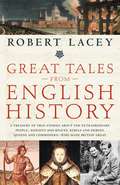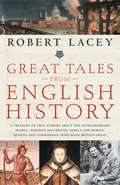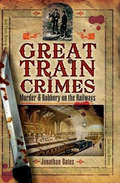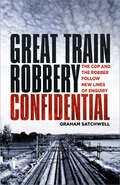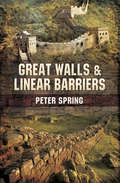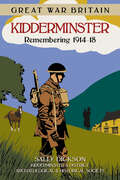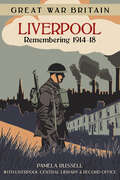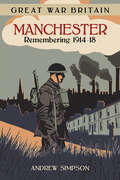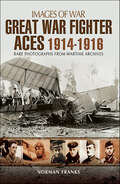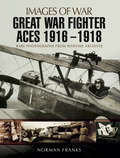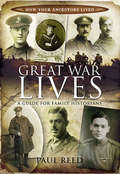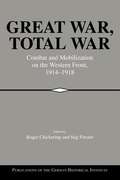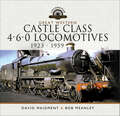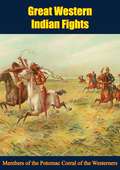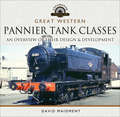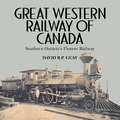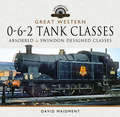- Table View
- List View
Great Tales from English History: A Treasury of True Stories about the Extraordinary People - Knights and Knaves, Rebels and Heroes, Queens and Commoners - Who Made Britain Great
by Robert Lacey<p>A feast for history lovers--the whole colorful parade of English history brilliantly captured in a single volume. <p>From ancient times to the present day, the story of England has been laced with drama, intrigue, courage, and passion. In GREAT TALES FROM ENGLISH HISTORY, Robert Lacey recounts the remarkable episodes that shaped a nation as only a great storyteller can: by combining impeccable accuracy with the timeless drama that has made these tales live for centuries. <p>This new paperback edition is encyclopedic in scope, gathering together all of Robert Lacey's great tales previously published in three separate hardcover volumes. <p>The book comprises 154 delectable stories, each brimming with insight, humor, and fascinating detail. Bite-sized history at its best, GREAT TALES FROM ENGLISH HISTORY belongs on every Anglophile's bookshelf.</p>
Great Tales from English History: Captain Cook, Samuel Johnson, Queen Victoria, Charles Darwin, Edward the Abdicator, and More
by Robert Lacey- With insight, humor and fascinating detail, Robert Lacey brings brilliantly to life the stories that made England. From Ethelred the Unready to Richard the Lionheart, the Venerable Bede to Piers the Ploughman, this is, quite simply, history as history should be told.- Lacey's bestseller "The Year 1000 has netted 120,000 copies in hardcover and paperback combined.- In the bestselling tradition of "How the Irish Saved Civilization, this is popular, accessible, bite-sized history at its best.
Great Tales from English History: Joan of Arc, The Princes in the Tower, Bloody Mary, Oliver Cromwell, Sir Isaac Newton, and More (Book #2)
by Robert LaceyWith insight, humor and fascinating detail, Robert Lacey brings brilliantly to life the stories that made England.
Great Tales from English History: The Truth About King Arthur, Lady Godiva, Richard the Lionheart, and More
by Robert LaceyFrom ancient times to the present day, the story of England has been laced with drama, intrigue, courage, and passion-a rich and vibrant narrative of heroes and villains, kings and rebels, artists and highwaymen, bishops and scientists. Now, in Great Tales from English History, Robert Lacey tells those remarkable stories as only a great writer can: combining impeccable accuracy with the timeless drama that has made these stories live for centuries.This volume begins in 7150 BC with the life and death of Cheddar Man and ends in 1381 with Wat Tyler and the Peasants' Revolt. We meet the Greek navigator Pytheas, whose description of the woad-painted Celts yielded pretanniki ("the land of the painted people"), which became the Latin word Britannia. We learn what the storytellers really meant when they described Lady Godiva's "naked" ride through town. And we discover the truth behind the tales of King Arthur and the infamous Hobbehod, later known as Robin Hood.With insight, humor, and fascinating detail, Robert Lacey brings brilliantly to life the stories that made England. From Ethelred the Unready to Richard the Lionheart, the Venerable
Great Train Crimes: Murder & Robbery on the Railways
by Jonathan OatesMurder and robbery committed on the railways have long held a special place in British criminal history. Railways and trains create special conditions—and opportunities—for criminal acts. Two legendary large-scale robberies took place on the British railways—the Gold Bullion Robbery of 1855 and the Great Train Robbery of 1963—and these extraordinary episodes are often used as examples of the ultimate in criminal audacity. <p><p> But as Jonathan Oates shows in this powerful selection of case studies, most railway crime is less sensational yet, in many ways, more revealing. He reconstructs in vivid detail some of the most memorable cases dating from Victorian times to the present day. Included are cases of adults and children who were thrown to their deaths from trains, decapitated corpses found beside railway lines, passengers who were pushed from platforms into the path of oncoming trains, and others who were stabbed, shot, or strangled during their journeys and were found dead on arrival. <p> The sheer variety of crimes is astonishing, as are the stories that unravel behind them. As he retells these sensational, bizarre, often ghastly tales, Oates gives an insight into the reality of railway crime. His collection is a must for addicts of true crime cases and for readers who enjoy railway history.
Great Train Robbery Confidential: The Cop and the Robber Follow New Lines of Enquiry
by Graham SatchwellIn 1981, Detective Inspector Satchwell was the officer in charge of the case against Train Robber Tom Wisbey and twenty others. The case involved massive thefts from mail trains – similar to the Great Train Robbery of 1963 where £2.6 million was taken and only £400,000 ever recovered. Thirty years later their paths crossed again and an unlikely partnership was formed, with the aim of revealing the truth about the Great Train Robbery. This book reassesses the known facts about one of the most infamous crimes in modern history from the uniquely qualified insight of an experienced railway detective, presenting new theories alongside compelling evidence and correcting the widely accepted lies and half-truths surrounding this story.
Great Transformations
by Mark BlythThis book picks up where Karl Polanyi's study of economic and political change left off. Building upon Polanyi's conception of the double movement, Blyth analyzes the two periods of deep seated institutional change that characterized the twentieth century: the 1930s and the 1970s. Blyth views both sets of changes as part of the same dynamic. In the 1930s labor reacted against the exigencies of the market and demanded state action to mitigate the market's effects by 'embedding liberalism. ' In the 1970s, those who benefited least from such 'embedding' institutions, namely business, reacted against these constraints and sought to overturn that institutional order. Blyth demonstrates the critical role economic ideas played in making institutional change possible. Great Transformations rethinks the relationship between uncertainty, ideas, and interests, achieving profound new insights on how, and under what conditions, institutional change takes place.
Great Unsolved Crimes
by Louis SolomonIf Lizzie Borden didn't kill her parents, who did? And where's the missing ax? What happened to the $200,000 the invisible hijacker jumped out of a 727 jet with? And what happened to the hijacker? Where would you look for the first child ever kidnapped? And why wouldn't you find him? Plus three other stories in which someone gets away with a major crime, even murder. Six perfect crimes. The police files are still open! The cases are still unsolved! Your solution is as good as anyone else's.
Great Walls and Linear Barriers
by Peter SpringEveryone has heard of the Great Wall of China and knows of Hadrian's Wall and the other barriers lining stretches of Rome's imperial frontiers. But Peter Spring's original new study demonstrates that far from being exceptional, the building of walls and other linear defences was commonplace among the peoples and states of pre-modern era. He finds examples virtually all across the globe and analyses their forms and strategic functions. He finds patterns for their distribution, an important recurrent theme being the divide between settled agriculture and nomads. The author argues that it is mistaken to view such undertakings as necessarily purely defensive measures that might be evidence of insecurity or a 'maginot line mentality', as they were in fact often about aggressive assertion of control over a region or strategic routes. This original and thought-provoking study brings new light and insight to a fascinating and neglected aspect of human political and military history. It The clear text is supported by numerous, specially drawn maps and photographs.
Great War Britain Coventry: Remembering 1914-18
by Peter Walters Culture Culture Coventry Culture CoventryThe First World War claimed over 995,000 British lives, and its legacy continues to be remembered today. Great War Britain: Coventry offers an intimate portrayal of the city and its people living in the shadow of the 'war to end all wars'. A beautifully illustrated and highly accessible volume, it describes local reaction to the outbreak of war; charts the experience of individuals who enlisted; the changing face of industry; the work of the many hospitals in the area; the effect of the conflict on local children; the women who defied convention to play a vital role on the home front; and concludes with a chapter dedicated to how the city and its people coped with the transition to life in peacetime once more. The Great War story of Coventry is told through the voices of those who were there and is vividly illustrated through evocative images from the archives of Culture Coventry.
Great War Britain Kidderminster: Remembering 1914-18
by Sally Dickson Kidderminster Historical Kidderminster Historical Society Kidderminster & District Archaeological & Historical SocietyThe First World War claimed over 995,000 British lives, and its legacy continues to be remembered today. Great War Britain: Kidderminster offers an intimate portrayal of the town and its people living in the shadow of the Great War for five years. A beautifully illustrated and highly accessible volume it explores the town’s recruiting drives, the background and fate of the area’s men on the frontline, the changing face of industry, the vital role of women, conscientious objectors, hospitals for the wounded and rehabilitation, peace celebrations, the fallen heroes and war memorials. The Great War story of Kidderminster is told through the voices of those who were there and is vividly illustrated through evocative images.
Great War Britain Liverpool: Remembering 1914-18
by Pamela RussellThe First World War claimed over 995,000 British lives, and its legacy continues to be remembered today.Great War Britain: Liverpool offers a detailed insight into this great city and its people facing the challenges of wartime. This highly accessible volume explores the city's regiments, and includes many individual stories of men on the frontline and the vital role of women against the background of the changing face of industry, attitudes to conscientious objectors, hospitals for the wounded and their rehabilitation, peace celebrations, the fallen heroes and how they are commemorated. Liverpool Central Library & Record Office have generously made available illustrative and other material from their extensive archives.
Great War Britain Manchester: Remembering 1914-18
by Andrew SimpsonThe First World War claimed over 995,000 British lives, and its legacy continues to be remembered today. Great War Britain: Manchester offers an intimate portrayal of the city and its people living in the shadow of the Great War. A beautifully illustrated and highly accessible volume, it explores the city's regiments, the background and fate of the men on the frontline, the changing face of industry, the vital role of women, conscientious objectors, hospitals for the wounded and rehabilitation, peace celebrations, the fallen heroes and war memorials. The Great War story of Manchester is told through the voices of those who were there and is vividly illustrated with evocative images.
Great War Britain Middlesbrough: Remembering 1914-18
by Paul Menzies Dorman Dorman Museum Dorman MuseumThe First World War claimed over 995,000 British lives, and its legacy continues to be remembered today. Great War Britain: Middlesbrough offers an intimate portrayal of the city and its people living in the shadow of the ‘war to end all wars’. A beautifully illustrated and highly accessible volume, it describes local reaction to the outbreak of war; charts the experience of individuals who enlisted; the changing face of industry and related unrest; the work of the many hospitals in the area; the effect of the conflict on local children; and concludes with a chapter dedicated to how the city and its people coped with the transition to life in peacetime once more. The Great War story of Middlesbrough is told through the voices of those who were there and is vividly illustrated through evocative images.
Great War Fighter Aces, 1914–1916 (Images of War)
by Norman FranksHere, Norman Franks tells the story, in words and images, of the emergence of some of the greatest fighter aces to see action during the first half of the First World War. He explores the manner in which the situation developed from late 1914 to the late summer of 1916, the point at which Oswald Boelcke helped form the German Jasta system that would prove so devastating to the RFC and RNAS. Utilizing images drawn from his large personal archive of photographs, Franks profiles some of the greatest and most notorious aces, as well as the aircraft in which they flew. The first years of the war saw some of the bravest acts of pilot gallantry and ingenuity play out. Franks celebrates the legacy of just a handful of these individuals, participants on both sides, including Boelcke's premier ace Manfred Von Richtofen, Lanoe Hawker, Georges Guynemer, Albert Ball, Lionel Rees, Wilhelm Frankl, and Stanley Dallas amongst many others.
Great War Fighter Aces, 1916–1918: Rare Photographs from Wartime Archives (Images of War)
by Norman FranksBy the close of 1916, the air war over France was progressing amazingly. The Royal Flying Corps, the French Air Force and the opposing German Air Service, were all engaged in fierce aerial conflict and the Allied air forces were following a particularly successful if aggressive policy. They were taking the war to the Germans by constantly crossing the massive trench system that stretched from the North Sea to the Swiss border. With observation and bombing aircraft requiring constant protection from the German fighter Jastas, the fighter aces on both sides soon gained publicity and fame as a result of their daily engagements. This book explores the many ways in which fighter pilots developed tactics in order to outdo the opposition in the fight for allied victory. In so doing, they achieved high honors on account of their prowess in the skies. It also looks at the development of militarized flight during the course of these key years, revealing how each side constantly endeavored to improve their aircraft and their gunnery.By early 1918 the Americans were also starting to take part in the war against Germany, and any number of US citizens were joining both the French Air Service as well as manning their own Aero Squadrons. This publication covers the development of American air combat, whilst also recording the efforts of some of their ace pilots flying both British and French aircraft with precision and skill.
Great War Lives: A Guide for Family Historians (How Your Ancestors Lived)
by Paul ReedThe Great War was a key event of the twentieth century and it is one of the most popular and rewarding areas for historical research—and for family historians. More records than ever are available to researchers whose relatives served during the war, and Paul Reeds new book is the perfect guide to how to locate and understand these sources—and get the most out of them.In fascinating detail he follows the stories of twelve service men who fought and died in the Great War a rifleman, an infantry officer, a tunneller, a gunner, a Royal Marine, a naval rating, an airman, and others. He describes their wartime careers and shows how they fitted into the armed forces. He looks at what they did, at their lives in the front line, in the rear areas, on leave, and at the conditions they endured and the experiences they had. And he demonstrates how the research was done and how the lives of these individuals were reconstructed—the methods that were used, the sources that were consulted.Paul Reeds informative and accessible book will be essential reading and reference for anyone who wants to find out about the Great War and is keen to understand the part an ancestor played in it.
Great War, Total War: Combat and Mobilization on the Western Front, 1914-1918
by Roger Chickering Stig Förster Christof Mauch David LazarThis volume analyzes the First World War in light of the concept of "total war," particularly the systematic erosion of the distinction between the military and civilian spheres. Leading scholars from Europe and North America explore the efforts of soldiers and statesmen, industrialists and financiers, professionals and civilian activists to adjust to the titanic, pervasive pressures that the military stalemate on the western front imposed on belligerent and neutral societies.
Great Western Castle Class 4-6-0 Locomotives, 1923–1959 (Locomotive Portfolios)
by David Maidment Bob MeanleyThe Great Western Castles were one of the most successful locomotive designs of the twentieth century in terms of both performance and efficiency. Designed by Charles Collett in 1923, based on the 1907 Churchward ‘Star’ class, 155 were constructed almost continuously, apart from the war years, between 1923 and 1950, in addition to fifteen rebuilt ‘Stars’ and one rebuilt from the Great Bear pacific. Many were modernised with increased superheat and double-chimneys in the late 1950s and the class continued to be the mainstay of all Western Region express passenger services to the West Country, South Wales, Gloucestershire, Herefordshire and the West Midlands until replaced by the WR diesel hydraulic fleet in the early 1960s. This book covers their design in a chapter written by Bob Meanley, who masterminded the restoration at Tyseley Works of the Castles Earl of Mount Edgcumbe and Clun Castle, and their history, operation and performance from the high speed of the 1930s through to their rejuvenation in the 1950s, leaving experience of their last years and preservation to another volume. David Maidment had close experience of the class when working at Old Oak Common between 1957 and 1962 and includes his personal experiences there and on the road from his first encounter with one as a six-year old boy. The book includes 350 photographs, some 40 in color, and 23 detailed Swindon technical drawings.
Great Western Indian Fights
by Members of the Potomac Corral of the WesternersFrom 1832 to 1891 the states from the Great Lakes west to Oregon and south to Mexico saw scenes of massacre, bloody rout, ambush, fire, and pillage as the great Indian tribes-Blackfoot, Cheyenne, Sioux, Arapaho, Modoc, and Apache-fought desperately to turn back the invading white men.Recreated in this volume, original published in 1960, are twenty-odd battles crucial in the opening of the American West to white settlement. Among the battles included here are the Pierre’s Hole fight, the battle of Bandera Pass, the battle of Pyramid Lake, the battle of Wood Lake, the Canyon de Chelly rout, the battles of Adobe Walls, the Fetterman, Hayfield, and Wagon Box fights, the fight at Beecher Island, the battle of the Washita, the battles of Massacre Canyon and Palo Duro Canyon, the battle of the Rosebud, the battle of the Little Bighorn, the Dull Knife massacre, and the final, tragic battle at Wounded Knee.“A fine guide to the conflict that transpired across the wide Missouri.”—San Francisco Sunday Chronicle“An excellent account of most of the major fights between the white man and the Indian in…the western part of the United States.”—Library Journal“Two dozen of the most celebrated and hair-raising Indian fights on record. Good, solid reading, and a whole peck of it.”—New York Times Book Review
Great Western Pannier Tank Classes: An Overview of Their Design & Development (Locomotive Portfolios)
by David MaidmentThis comprehensive and fully illustrated history presents an in-depth look at the Great Western Railway&’s various pannier tank engines. Though hauling freight was a vital part of Great Western Railway&’s history—and where it made the majority of its profit—there are few books devoted to the stout, powerful engines that did the work. In Great Western, Pannier Tank Classes, British Railways expert David Maidment corrects that oversight. This volume explores the large number of 0-6-0 saddle tanks built for both the Great Western Railway and the independent railway companies in South Wales, most of which were converted to pannier tanks in the Churchward and Collett eras. While covering the Armstrong and Dean engines in detail, Maidment goes on to describe the design, construction and operation of the largest class of steam engines built in the UK in the last century: Charles Collett&’s GWR 5700 class, examples of which were still being built after nationalization. Collett also designed pannier tank engines for branch passenger and freight work, and his successor Frederick Hawksworth continued the GW tradition with a tapered boiler version. All of these are discussed in depth in terms of their design and service. A concluding chapter covers further designs that were never built.
Great Western Pannier Tank Classes: An Overview of Their Design & Development (Locomotive Portfolios)
by David MaidmentThis comprehensive and fully illustrated history presents an in-depth look at the Great Western Railway&’s various pannier tank engines. Though hauling freight was a vital part of Great Western Railway&’s history—and where it made the majority of its profit—there are few books devoted to the stout, powerful engines that did the work. In Great Western, Pannier Tank Classes, British Railways expert David Maidment corrects that oversight. This volume explores the large number of 0-6-0 saddle tanks built for both the Great Western Railway and the independent railway companies in South Wales, most of which were converted to pannier tanks in the Churchward and Collett eras. While covering the Armstrong and Dean engines in detail, Maidment goes on to describe the design, construction and operation of the largest class of steam engines built in the UK in the last century: Charles Collett&’s GWR 5700 class, examples of which were still being built after nationalization. Collett also designed pannier tank engines for branch passenger and freight work, and his successor Frederick Hawksworth continued the GW tradition with a tapered boiler version. All of these are discussed in depth in terms of their design and service. A concluding chapter covers further designs that were never built.
Great Western Railway of Canada: Southern Ontario’s Pioneer Railway
by David R.P. GuayA look back on the brief and spectacular history of Canada’s Great Western Railway. This book chronicles the genesis and all-too-brief existence of one of Canada’s greatest early railways, the Great Western Railway of Canada (1853–1882), a major precursor to the Canadian National Rail system. Today, the Great Western Railway of Canada is a little-known historic line, overlooked even by many railway aficionados. But it was truly a railway ahead of its time. It was a pioneer in combining land- and water-based transportation, including the introduction of river car-ferries and passenger/freight steamships on the Great Lakes. It made waves of a different kind with its acquisition of the American-owned railway linking Detroit, Grand Haven, and Milwaukee. And its mammoth workshops were industrial monuments in Hamilton and London, Ontario, where inventive geniuses laboured to supply the booming rail trade of southern Ontario. It was the ancestor of some of the most heavily used rail lines in all of Canada. This book has been written to do justice to a railway that truly must be considered one of Canada’s trailblazing lines. Amply illustrated with previously unpublished photographs and a thorough historical record of the Great Western Railway’s locomotives and rolling stock, it offers a ride back in time into the vanishing history of early Ontario railroading.
Great Western, 0-6-2 Tank Classes: Absorbed & Swindon Designed Classes (Locomotive Portfolios)
by David MaidmentDescriptions and hundreds of photos of these tank engines that played a major role in Welsh coal mining and passenger rail.After tackling the Great Western Railway’s pannier tanks in a previous Locomotive Portfolios volume, David Maidment seeks out descriptions and photographs of the GW 0-6-2 tank engines, the majority of which were built by the Rhymney, Taff Vale, Barry, and other Welsh railways from the last decade or so of the nineteenth century onward. The engines of eight different companies, absorbed by the GWR in 1922, are described and illustrated, as well as the way in which many were modernized and rebuilt at Swindon or Caerphilly Works in the 1920s. GWR Chief Mechanical Engineer Charles Collett was, however, faced with a motive power crisis in the mining valleys at the Grouping, as many of the companies had economized on essential maintenance as the GW’s takeover drew near, and he had to hurriedly design a standard 0-6-2T to complement and bolster their work as the powerful GW 2-8-0Ts were too heavy and wide for many of the Cardiff valleys. These engines, the 56XX & 66XX classes, became part of the South Wales scene between 1925 and 1964, mainly running the coal traffic between pits and docks, although they dominated Cardiff Valley passenger services until the influx of BR 3MT 2-6-2Ts and GW 41XX 2-6-2Ts in 1954 and 1955. With around 300 black & white photographs, this book takes a wide-ranging look at these locomotives.
Great Western, 0-6-2 Tank Classes: Absorbed & Swindon Designed Classes (Locomotive Portfolios)
by David MaidmentDescriptions and hundreds of photos of these tank engines that played a major role in Welsh coal mining and passenger rail.After tackling the Great Western Railway’s pannier tanks in a previous Locomotive Portfolios volume, David Maidment seeks out descriptions and photographs of the GW 0-6-2 tank engines, the majority of which were built by the Rhymney, Taff Vale, Barry, and other Welsh railways from the last decade or so of the nineteenth century onward. The engines of eight different companies, absorbed by the GWR in 1922, are described and illustrated, as well as the way in which many were modernized and rebuilt at Swindon or Caerphilly Works in the 1920s. GWR Chief Mechanical Engineer Charles Collett was, however, faced with a motive power crisis in the mining valleys at the Grouping, as many of the companies had economized on essential maintenance as the GW’s takeover drew near, and he had to hurriedly design a standard 0-6-2T to complement and bolster their work as the powerful GW 2-8-0Ts were too heavy and wide for many of the Cardiff valleys. These engines, the 56XX & 66XX classes, became part of the South Wales scene between 1925 and 1964, mainly running the coal traffic between pits and docks, although they dominated Cardiff Valley passenger services until the influx of BR 3MT 2-6-2Ts and GW 41XX 2-6-2Ts in 1954 and 1955. With around 300 black & white photographs, this book takes a wide-ranging look at these locomotives.
